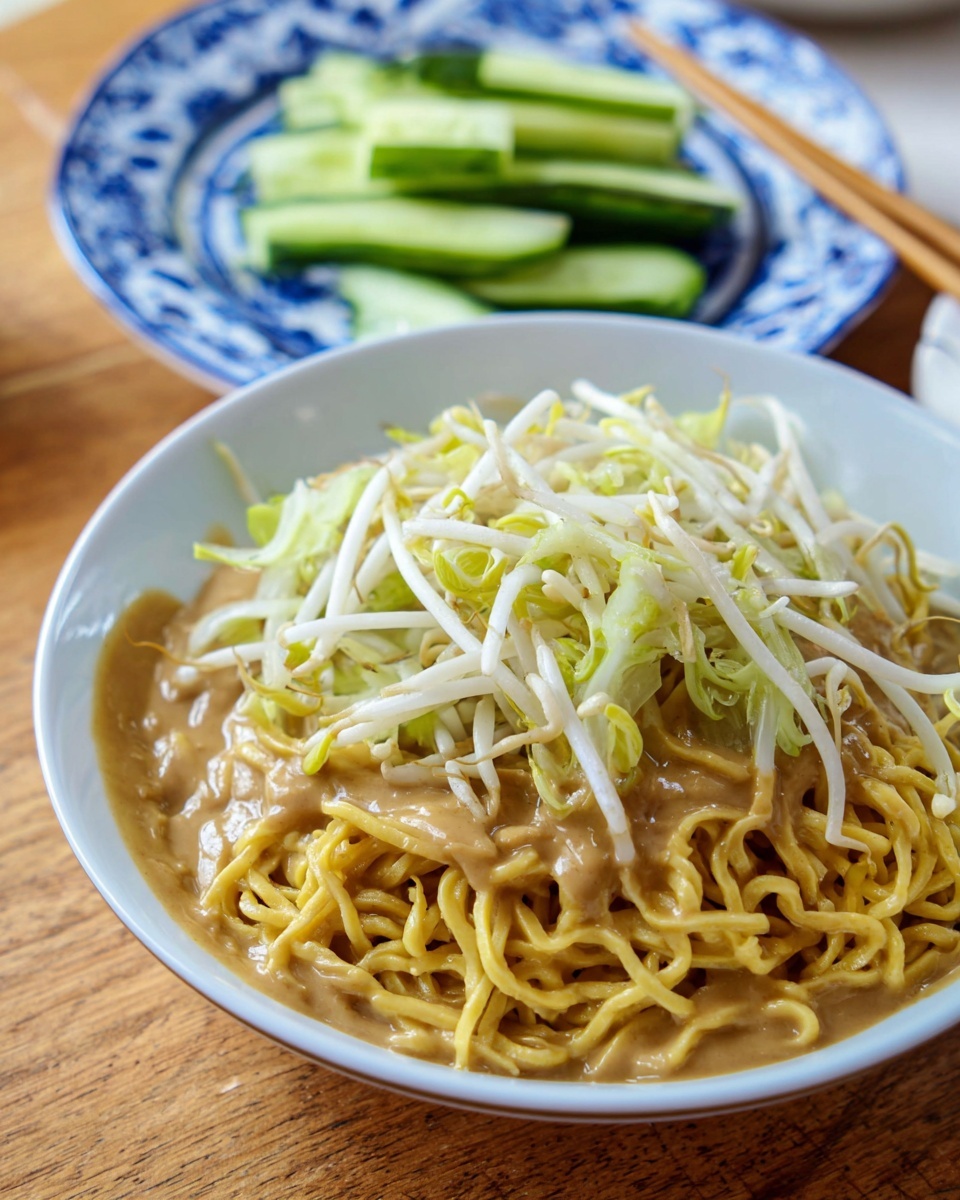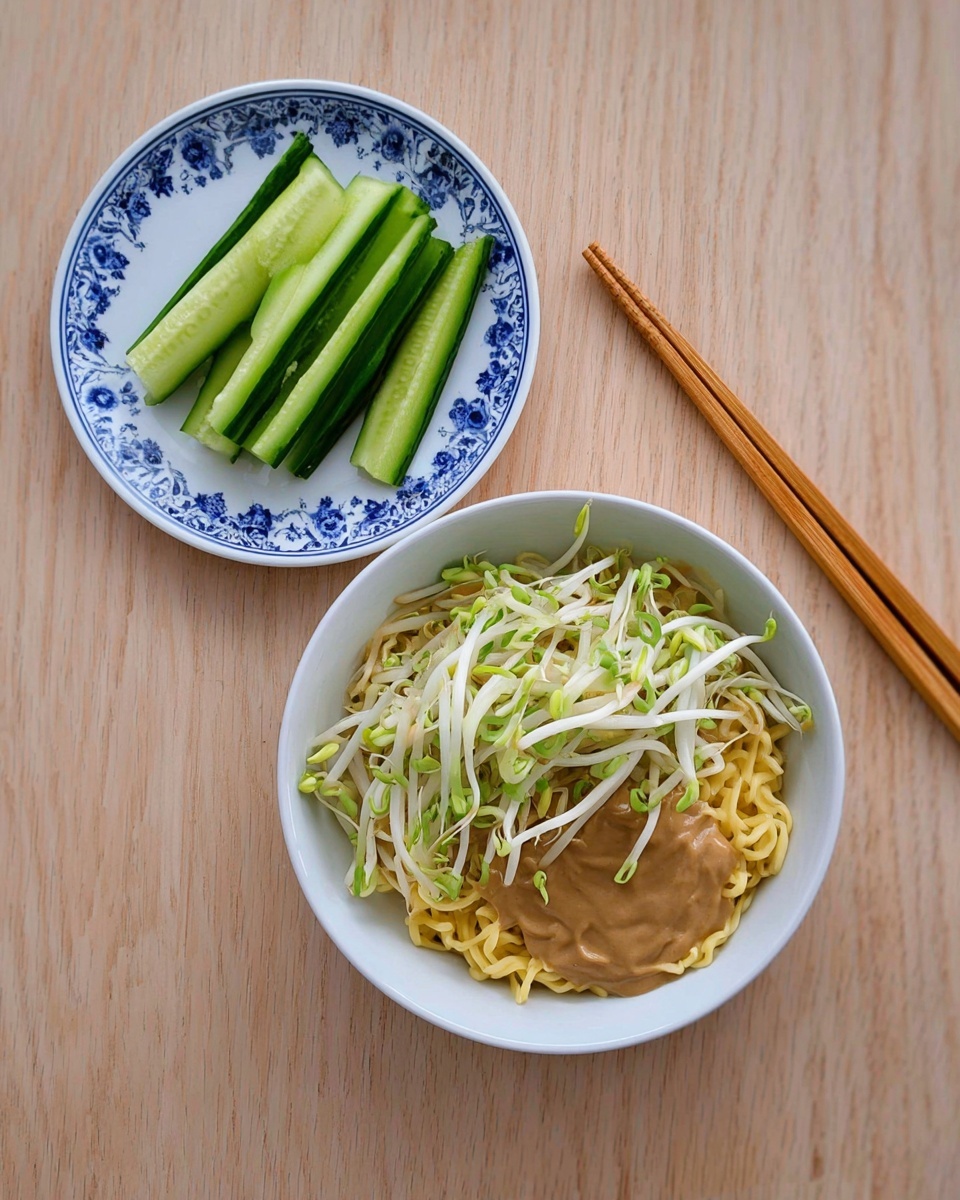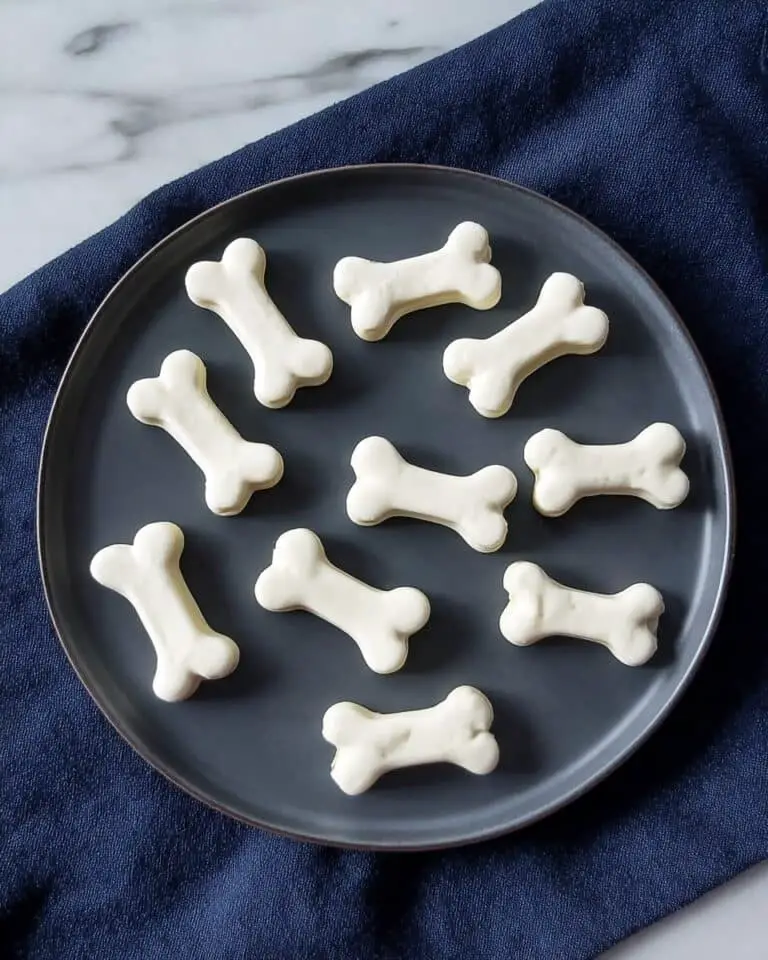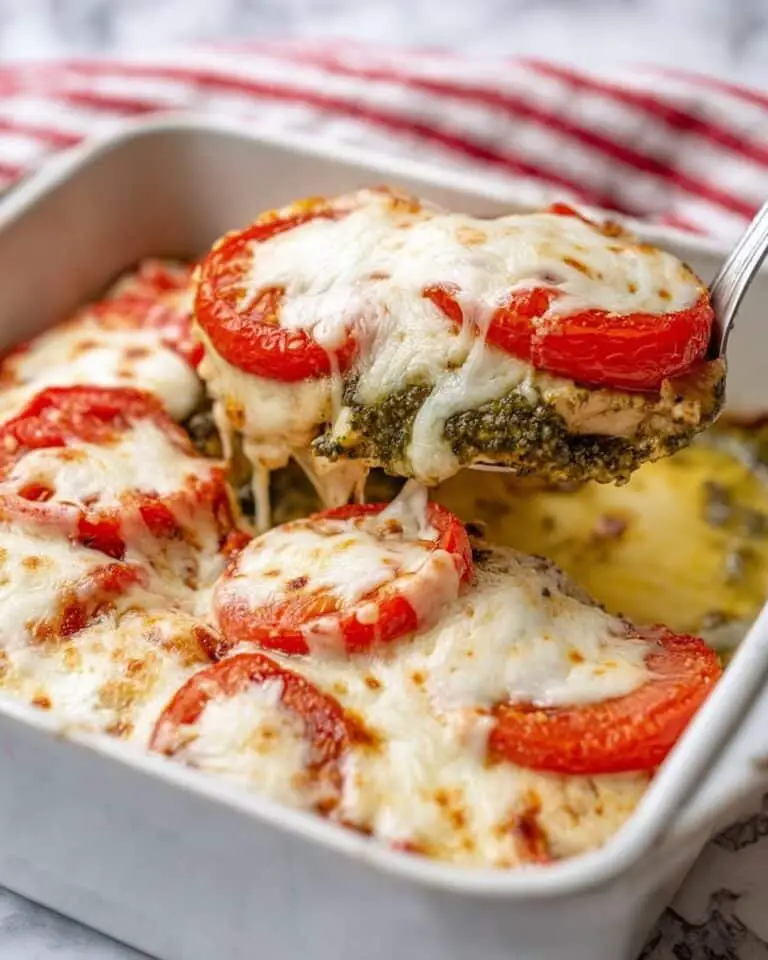If you’re craving something quick, flavorful, and a little different, you’re going to love this 10-Minute Authentic Taiwanese Cold Noodles Recipe. It’s one of those dishes I keep coming back to when I want a fast, satisfying meal that doesn’t skimp on taste. The creamy sesame sauce paired with tender noodles and crunchy beansprouts just hits the spot every time. Plus, it’s crazy simple to whip up—you’ll be amazed how a handful of ingredients turns into something restaurant-quality in no time!
Why You’ll Love This Recipe
- Speedy Prep: Ready from start to finish in just 10 minutes—perfect for busy days or last-minute meals.
- Authentic Flavors: The toasted sesame paste sauce is the real deal, giving you that rich, nutty taste that Taiwanese cold noodles are known for.
- Versatile Dish: Enjoy it hot or cold, and customize toppings to suit your mood or pantry staples.
- Family Favorite: Simple enough for weeknights, but impressive enough to serve guests who love Asian flavors.
Ingredients You’ll Need
Each ingredient in this 10-Minute Authentic Taiwanese Cold Noodles Recipe plays a key part in balancing the flavors and textures. The sauce is where the magic happens, so make sure to grab good-quality Chinese sesame paste and fresh garlic for that punch of flavor.
- Chinese sesame paste: Look for a thick, creamy paste—this is the heart of the sauce and what gives it that rich, nutty flavor.
- Sesame oil: Use for aromatic depth; double the amount if you swap in peanut butter instead of sesame paste.
- Garlic (crushed): Fresh and pungent, it wakes the sauce up—don’t skimp here!
- Light soy sauce: Adds salty umami without overpowering the sesame taste.
- Black vinegar (or rice/wine vinegar): Just a hint for subtle sourness that brightens the sauce.
- Fine sugar: Balances out the sour and salty components with a touch of sweetness.
- Fine salt: Enhances flavors; add carefully since soy sauce already adds salt.
- Ground white pepper: Offers gentle heat and slight earthiness—black pepper works too if you prefer.
- Egg or buckwheat noodles: I love using egg noodles for their springy texture, but buckwheat is a great alternative with a different bite.
- Beansprouts: Adds crunch and freshness, plus they only take a minute to cook in the noodle water.
- Spring onions (thinly sliced): The perfect fresh garnish to finish off the dish with color and mild onion flavor.
Variations
This 10-Minute Authentic Taiwanese Cold Noodles Recipe is wonderfully adaptable! I often tweak it depending on the season or what’s in my fridge—there’s something so satisfying about making it your own while still capturing the core flavors.
- Spicy kick: I like to drizzle it with a bit of Lee Kum Kee Chiu Chow chili oil for heat—works wonders if you love spice.
- Vegetarian version: Swap light soy sauce for a vegetarian tamari, and load up extra veggies like cucumber or shredded carrot for crunch.
- Nut-free: If you’re allergic, try tahini blended with a dash of sesame oil to replicate that creamy texture without the nuts.
- Cold vs. warm: While cold noodles are classic, my family sometimes enjoys it warm in chilly weather—you can heat just before serving!
How to Make 10-Minute Authentic Taiwanese Cold Noodles Recipe
Step 1: Whip Up the Sesame Sauce
Start by mixing all your sauce ingredients in a bowl—Chinese sesame paste, sesame oil, crushed garlic, light soy sauce, black vinegar, sugar, salt, and white pepper. I always taste as I go because you want the sauce to be bold: the sesame flavor should be strong, with saltiness at the forefront. If it tastes a bit too salty at this point, don’t worry—it’ll mellow once mixed with the noodles. Remember, the vinegar and sugar are background players, just enough to add subtle balance and shine.
Step 2: Cook the Noodles and Beansprouts
Bring a pot of lightly salted water to a boil, then add your noodles. Follow the packet’s cooking time, but here’s my trick: add the beansprouts to the boiling water about 90 seconds before the noodles are done. This way, everything finishes perfectly together and the beansprouts stay crisp yet tender. Drain them both together and reserve about 150-200ml of the cooking water—it comes in handy next.
Step 3: Loosen the Sauce and Combine
Add the reserved hot cooking water gradually into your sesame sauce, mixing well to loosen it up and lighten the color. This step is a game-changer! You’ll get a glossy, silky sauce that coats every strand of noodle beautifully without being too thick or gloopy. Then transfer the noodles and beansprouts into serving bowls, scatter spring onions on top, and pour the sauce over—or let your guests mix it themselves at the table.
Pro Tips for Making 10-Minute Authentic Taiwanese Cold Noodles Recipe
- Taste the Sauce Early: Before you add the noodle water, make sure the seasoning hits a bold balance; it’ll dilute once mixed.
- Cook Beansprouts Last: Adding sprouts right before the noodles finish ensures they’re perfectly tender-crisp, not soggy.
- Use Reserved Cooking Water: This is the secret to that perfect sauce texture—don’t skip it!
- Noodles Choice Matters: Egg noodles provide extra spring and bite, but buckwheat noodles add lovely earthiness—choose based on your mood.
How to Serve 10-Minute Authentic Taiwanese Cold Noodles Recipe
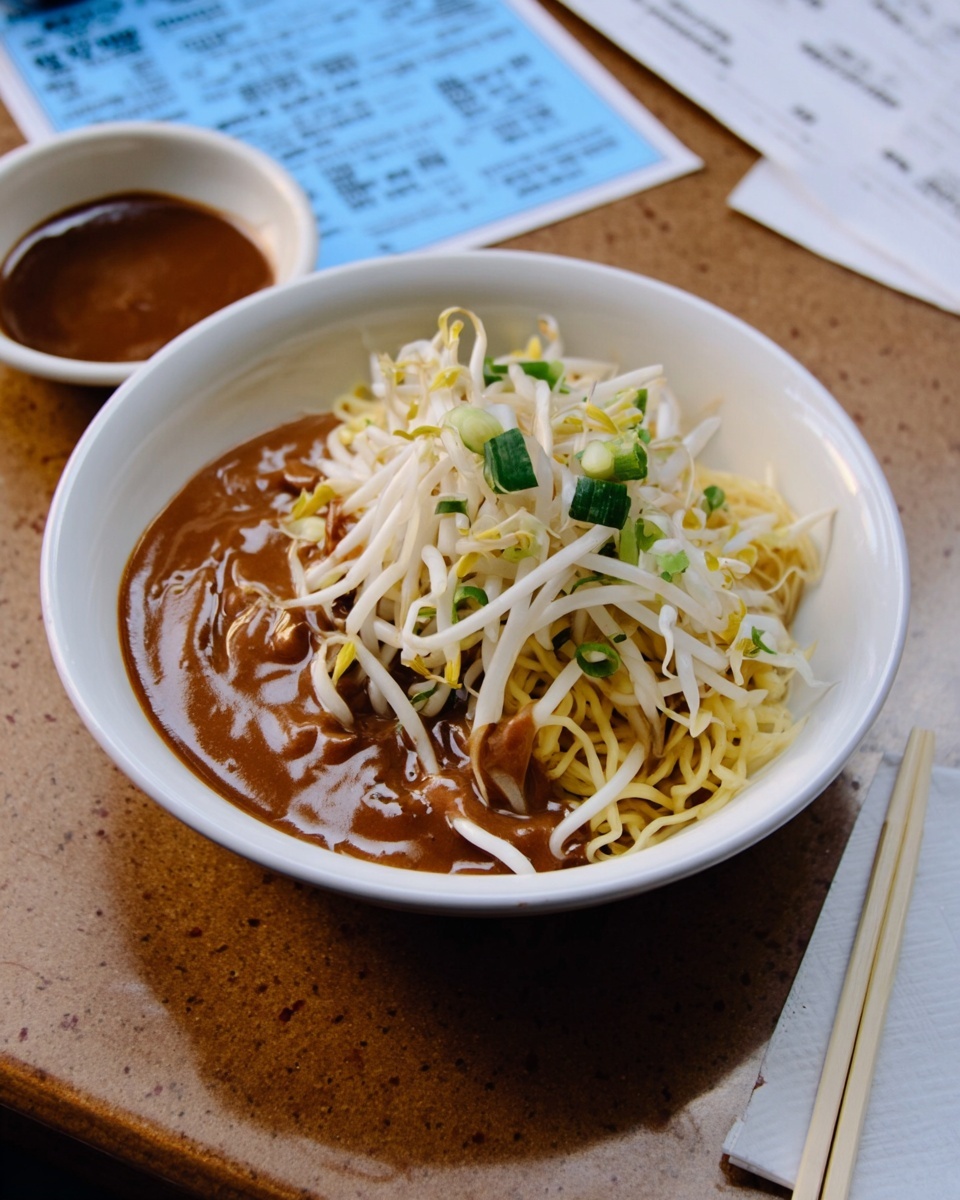
Garnishes
I always finish these cold noodles with fresh spring onions for brightness and a bit of fresh crunch. Sometimes I add finely shredded Taiwanese cucumber or a sprinkle of toasted sesame seeds if I’m feeling fancy. Those simple garnishes make a big difference in elevating the dish visually and flavor-wise.
Side Dishes
To make it a full meal, pair with a light Taiwanese cucumber salad or some quick pickled radishes for a tart contrast. For an extra kick, chili oil is my go-to—keep a bottle of Lee Kum Kee’s authentic chili oil handy for drizzling. These sides balance the richness of the noodles perfectly.
Creative Ways to Present
When I’ve served this at casual dinners, I like to pile the noodles in shallow bowls and serve the sauce on the side, letting everyone drizzle and mix to taste. For summer parties, chilling the noodles beforehand and serving in colorful glass bowls topped with cucumber ribbons makes a refreshing, beautiful presentation that always impresses.
Make Ahead and Storage
Storing Leftovers
If you have leftovers, I recommend storing the noodles and sauce separately to keep textures fresh. Keep the noodles in an airtight container in the fridge for up to two days, and the sauce in a small jar. This way, you won’t end up with soggy noodles.
Freezing
I haven’t tried freezing this recipe because the texture of cooked noodles and fresh beansprouts doesn’t hold up well after thawing. I’d suggest making it fresh or storing in the fridge instead for the best flavor and texture.
Reheating
To reheat, warm the noodles briefly in hot water for about 30 seconds to loosen them up, then drain well. Reheat the sauce gently in a microwave or stovetop, mix together, and garnish fresh spring onions again. This method keeps the noodles from getting mushy while warming everything through.
FAQs
-
Can I make this recipe gluten-free?
Absolutely! Just swap out the regular egg noodles for gluten-free rice or buckwheat noodles. Double-check your soy sauce is gluten-free or use tamari instead. The sauce ingredients are naturally gluten-free, so it’s an easy swap that won’t compromise the authentic flavor.
-
Can I prepare the sauce ahead of time?
Yes, making the sauce ahead is a great time saver! Just keep it refrigerated in an airtight container. Before serving, add some hot cooking water from the noodles to loosen it up. Freshly crushed garlic is best added right away, but you can mix it into the sauce early if needed.
-
What noodles work best for this recipe?
I recommend egg noodles for their wonderful chew and springiness. Buckwheat noodles give a nutty flavor which complements the sesame sauce nicely, too. Whatever you pick, just avoid super thick noodles—they won’t let the sauce coat as beautifully.
-
Is this dish typically served hot or cold?
Traditionally, Taiwanese cold noodles are served chilled or at room temperature, especially in warmer months. But I’ve found it tastes excellent warm as well, making it a versatile dish all year round.
Final Thoughts
This 10-Minute Authentic Taiwanese Cold Noodles Recipe has a special place in my kitchen because it bridges speed and flavor so effortlessly. Whether you’re cooking for one or feeding a crowd, it never disappoints. Once you nail the sauce and toss it with the noodles and crisp beansprouts, you’ll see why my family goes crazy for it! Trust me, once you taste those creamy, nutty noodles with the bright spring onions and punch of garlic, it’ll become your go-to quick meal too. So, grab those ingredients and give it a whirl—you’ll be rewarded in less than ten minutes. Enjoy!
Print
10-Minute Authentic Taiwanese Cold Noodles Recipe
- Prep Time: 5 minutes
- Cook Time: 5 minutes
- Total Time: 10 minutes
- Yield: 2 servings
- Category: Main Course
- Method: Stovetop
- Cuisine: Taiwanese
Description
This authentic Taiwanese cold noodles recipe delivers a quick and flavorful dish featuring a rich sesame sauce, tender noodles, and crunchy beansprouts. Ready in just 10 minutes, it’s perfect for a refreshing meal with a balance of savory, nutty, and subtly tangy flavors.
Ingredients
Sauce Ingredients
- 4 tbsp Chinese sesame paste
- 2 tbsp sesame oil (double if using peanut butter)
- 6 cloves garlic (crushed)
- 6 tsp light soy sauce
- 1 tsp Chinese/Taiwanese black vinegar (or rice vinegar/wine vinegar as substitute)
- 2 tsp fine sugar
- ½ tsp fine salt
- 1 tsp ground white pepper (or a generous grind of black pepper)
Noodle Ingredients
- 280 g egg or buckwheat noodles (4 nests)
- 160 g beansprouts (2 handfuls)
- 4 spring onions (thinly sliced)
Instructions
- Prepare the sauce: In a bowl, thoroughly mix the Chinese sesame paste, sesame oil, crushed garlic, light soy sauce, black vinegar, sugar, salt, and ground white pepper. Taste and adjust seasoning ensuring the sauce has a strong sesame flavor, moderate saltiness, and subtle background sourness and sweetness.
- Cook noodles and beansprouts: Bring a pot of lightly salted water to boil. Add the noodles and cook per the package instructions. Add the beansprouts to the boiling water 90 seconds before the noodles finish cooking.
- Drain and reserve water: Drain the noodles and beansprouts in a colander, preserving 150-200ml of the cooking water.
- Loosen the sauce: Gradually stir the reserved cooking water into the sauce until it becomes lighter in color and has a glossy, pourable consistency that will coat the noodles well.
- Assemble and serve: Place the noodles and beansprouts in serving bowls. Sprinkle with thinly sliced spring onions. Pour the loosened sauce on top. Serve immediately, allowing diners to mix the dish themselves. Optional accompaniments include Taiwanese cucumber salad and chili oil, such as Lee Kum Kee Chinese Chiu Chow chili oil.
Notes
- The sesame paste-based sauce is hearty, thick, and glossy, providing a rich sesame flavor with balanced seasoning.
- This dish can be served hot or cold depending on preference.
- Doubling the sesame oil is recommended if substituting peanut butter for sesame paste to maintain flavor balance.
- The reserved noodle cooking water helps adjust sauce consistency and shine.
- Serving with cucumber salad and chili oil enhances freshness and spice levels.
Nutrition
- Serving Size: 1 serving
- Calories: 410 kcal
- Sugar: 4 g
- Sodium: 900 mg
- Fat: 18 g
- Saturated Fat: 2.5 g
- Unsaturated Fat: 13 g
- Trans Fat: 0 g
- Carbohydrates: 50 g
- Fiber: 3 g
- Protein: 14 g
- Cholesterol: 30 mg

